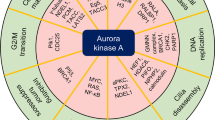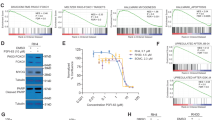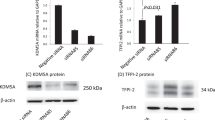Abstract
Evasion from apoptosis is a hallmark of cancer, and recent success using targeted therapeutics underscores the importance of identifying anti-apoptotic survival pathways. Here we utilize RNA interference (RNAi) to systematically screen the kinase and phosphatase component of the human genome. In addition to known kinases, we identified several new survival kinases. Interestingly, numerous phosphatases and associated regulatory subunits contribute to cell survival, revealing a previously unrecognized general role for phosphatases as negative regulators of apoptosis. We also identified a subset of phosphatases with tumour-suppressor-like activity. Finally, RNAi targeting of specific protein kinases sensitizes resistant cells to chemotherapeutic agents. The development of inhibitors that target these kinases or phosphatases may lead to new anti-cancer strategies.
This is a preview of subscription content, access via your institution
Access options
Subscribe to this journal
Receive 12 print issues and online access
$209.00 per year
only $17.42 per issue
Buy this article
- Purchase on Springer Link
- Instant access to full article PDF
Prices may be subject to local taxes which are calculated during checkout





Similar content being viewed by others
References
Hanahan, D. & Weinberg, R.A. The hallmarks of cancer. Cell 100, 57–70 (2000).
MacKeigan, J.P., Collins, T.S. & Ting, J.P. MEK inhibition enhances paclitaxel-induced tumor apoptosis. J. Biol. Chem. 275, 38953–38956 (2000).
Slamon, D.J. et al. Use of chemotherapy plus a monoclonal antibody against HER2 for metastatic breast cancer that overexpresses HER2. N. Engl. J. Med. 344, 783–792 (2001).
MacKeigan, J.P. et al. Inactivation of the antiapoptotic phosphatidylinositol 3-kinase-Akt pathway by the combined treatment of taxol and mitogen-activated protein kinase kinase inhibition. Clin. Cancer Res. 8, 2091–2099 (2002).
Pietras, K. et al. Inhibition of PDGF receptor signaling in tumor stroma enhances antitumor effect of chemotherapy. Cancer Res. 62, 5476–5484 (2002).
Hannon, G.J. & Rossi, J.J. Unlocking the potential of the human genome with RNA interference. Nature 431, 371–378 (2004).
Tassi, E., Biesova, Z., Di Fiore, P.P., Gutkind, J.S. & Wong, W.T. Human JIK, a novel member of the STE20 kinase family that inhibits JNK and is negatively regulated by epidermal growth factor. J. Biol. Chem. 274, 33287–33295 (1999).
Wishart, M.J., Denu, J.M., Williams, J.A. & Dixon, J.E. A single mutation converts a novel phosphotyrosine binding domain into a dual-specificity phosphatase. J. Biol. Chem. 270, 26782–26785 (1995).
Wishart, M.J. & Dixon, J.E. Gathering STYX: phosphatase-like form predicts functions for unique protein-interaction domains. Trends Biochem. Sci. 23, 301–306 (1998).
Schiff, P.B., Fant, J. & Horwitz, S.B. Promotion of microtubule assembly in vitro by taxol. Nature 277, 665–667 (1979).
Schiff, P.B. & Horwitz, S.B. Taxol stabilizes microtubules in mouse fibroblast cells. Proc. Natl Acad. Sci. USA 77, 1561–1565 (1980).
Sorenson, C.M., Barry, M.A. & Eastman, A. Analysis of events associated with cell cycle arrest at G2 phase and cell death induced by cisplatin. J. Natl Cancer Inst. 82, 749–755 (1990).
van Maanen, J.M., Retel, J., de Vries, J. & Pinedo, H.M. Mechanism of action of antitumor drug etoposide: a review. J. Natl Cancer Inst. 80, 1526–1533 (1988).
Brunet, A. et al. Protein kinase SGK mediates survival signals by phosphorylating the forkhead transcription factor FKHRL1 (FOXO3a). Mol. Cell. Biol. 21, 952–965 (2001).
Huang, S. & Houghton, P.J. Inhibitors of mammalian target of rapamycin as novel antitumor agents: from bench to clinic. Curr. Opin. Investig. Drugs 3, 295–304 (2002).
Bjornsti, M.A. & Houghton, P.J. The TOR pathway: a target for cancer therapy. Nature Rev. Cancer 4, 335–348 (2004).
Fingar, D.C. & Blenis, J. Target of rapamycin (TOR): an integrator of nutrient and growth factor signals and coordinator of cell growth and cell cycle progression. Oncogene 23, 3151–3171 (2004).
Senderowicz, A.M. Small-molecule cyclin-dependent kinase modulators. Oncogene 22, 6609–6620 (2003).
Pasleau, F., Grooteclaes, M. & Gol-Winkler, R. Expression of the c-erbB2 gene in the BT474 human mammary tumor cell line: measurement of c-erbB2 mRNA half-life. Oncogene 8, 849–854 (1993).
Lane, H.A. et al. ErbB2 potentiates breast tumor proliferation through modulation of p27Kip1-Cdk2 complex formation: receptor overexpression does not determine growth dependency. Mol. Cell. Biol. 20, 3210–3223 (2000).
Bonifati, V. et al. Mutations in the DJ-1 gene associated with autosomal recessive early-onset parkinsonism. Science 299, 256–259 (2003).
Valente, E.M. et al. Hereditary early-onset Parkinson's disease caused by mutations in PINK1. Science 304, 1158–1160 (2004).
MacKeigan, J.P. et al. Proteomic profiling drug-induced apoptosis in non-small cell lung carcinoma: identification of RS/DJ-1 and RhoGDIα. Cancer Res. 63, 6928–6934 (2003).
Cheng, J.Q. et al. AKT2, a putative oncogene encoding a member of a subfamily of protein-serine/threonine kinases, is amplified in human ovarian carcinomas. Proc. Natl Acad. Sci. USA 89, 9267–9271 (1992).
Datta, S.R., Brunet, A. & Greenberg, M.E. Cellular survival: a play in three Akts. Genes Dev. 13, 2905–2927 (1999).
Storz, P. & Toker, A. Protein kinase D mediates a stress-induced NF-κB activation and survival pathway. EMBO J. 22, 109–120 (2003).
Yang, B.F., Xiao, C., Roa, W.H., Krammer, P.H. & Hao, C. Calcium/calmodulin-dependent protein kinase II regulation of c-FLIP expression and phosphorylation in modulation of Fas-mediated signaling in malignant glioma cells. J. Biol. Chem. 278, 7043–7050 (2003).
Seton-Rogers, S.E. et al. Cooperation of the ErbB2 receptor and transforming growth factor β in induction of migration and invasion in mammary epithelial cells. Proc. Natl Acad. Sci. USA 101, 1257–1262 (2004).
Muraoka, R.S. et al. Increased malignancy of Neu-induced mammary tumors overexpressing active transforming growth factor β1. Mol. Cell. Biol. 23, 8691–8703 (2003).
Siegel, P.M., Shu, W., Cardiff, R.D., Muller, W.J. & Massague, J. Transforming growth factor β signaling impairs Neu-induced mammary tumorigenesis while promoting pulmonary metastasis. Proc. Natl Acad. Sci. USA 100, 8430–8435 (2003).
Di Cristofano, A., Pesce, B., Cordon-Cardo, C. & Pandolfi, P.P. Pten is essential for embryonic development and tumour suppression. Nature Genet. 19, 348–355 (1998).
Goberdhan, D.C., Paricio, N., Goodman, E.C., Mlodzik, M. & Wilson, C. Drosophila tumor suppressor PTEN controls cell size and number by antagonizing the Chico/PI3-kinase signaling pathway. Genes Dev. 13, 3244–3258 (1999).
Stambolic, V. et al. Negative regulation of PKB/Akt-dependent cell survival by the tumor suppressor PTEN. Cell 95, 29–39 (1998).
Suzuki, A. et al. High cancer susceptibility and embryonic lethality associated with mutation of the PTEN tumor suppressor gene in mice. Curr. Biol. 8, 1169–1178 (1998).
Murphy, L.O., MacKeigan, J.P. & Blenis, J. A network of immediate early gene products propagates subtle differences in mitogen-activated protein kinase signal amplitude and duration. Mol. Cell. Biol. 24, 144–153 (2004).
Alvarez, B., Martinez, A.C., Burgering, B.M. & Carrera, A.C. Forkhead transcription factors contribute to execution of the mitotic programme in mammals. Nature 413, 744–747 (2001).
Wang, Z. et al. Mutational analysis of the tyrosine phosphatome in colorectal cancers. Science 304, 1164–1166 (2004).
Narayan, G. et al. Genetic analysis identifies putative tumor suppressor sites at 2q35-q36.1 and 2q36.3-q37.1 involved in cervical cancer progression. Oncogene 22, 3489–3499 (2003).
Brondello, J.M., Pouyssegur, J. & McKenzie, F.R. Reduced MAP kinase phosphatase-1 degradation after p42/p44MAPK-dependent phosphorylation. Science 286, 2514–2517 (1999).
Makin, G. & Dive, C. Modulating sensitivity to drug-induced apoptosis: the future for chemotherapy? Breast Cancer Res. 3, 150–153 (2001).
Manning, G., Whyte, D.B., Martinez, R., Hunter, T. & Sudarsanam, S. The protein kinase complement of the human genome. Science 298, 1912–1934 (2002).
Tartaglia, M. et al. Mutations in PTPN11, encoding the protein tyrosine phosphatase SHP-2, cause Noonan syndrome. Nature Genet. 29, 465–468 (2001).
Mohi, M.G. et al. Prognostic, therapeutic, and mechanistic implications of a mouse model of leukemia evoked by Shp2 (PTPN11) mutations. Cancer Cell 7, 179–191 (2005).
Acknowledgements
We gratefully acknowledge E. Lader and S. Yerramilli for their assistance with siRNA library design and QRT–PCR expertise. We thank F. Tsai for help with data analysis, W. Dowdle for technical assistance, and C. Dimitri, B. Ballif and members of the Blenis laboratory for their critical feedback. This work is supported by National Institutes of Health grants RO1CA46595 and GM51405 to J.B. J.M. is a Fellow of the American Cancer Society and L.M. is a Special Fellow of the Leukemia & Lymphoma Society.
Author information
Authors and Affiliations
Corresponding author
Ethics declarations
Competing interests
The authors declare no competing financial interests.
Supplementary information
Supplementary information
Supplementary figures S1, S2, S3 and S4 (PDF 124 kb)
Rights and permissions
About this article
Cite this article
MacKeigan, J., Murphy, L. & Blenis, J. Sensitized RNAi screen of human kinases and phosphatases identifies new regulators of apoptosis and chemoresistance. Nat Cell Biol 7, 591–600 (2005). https://doi.org/10.1038/ncb1258
Received:
Accepted:
Published:
Issue Date:
DOI: https://doi.org/10.1038/ncb1258
This article is cited by
-
PINK1-PTEN axis promotes metastasis and chemoresistance in ovarian cancer via non-canonical pathway
Journal of Experimental & Clinical Cancer Research (2023)
-
Mitophagy in carcinogenesis, drug resistance and anticancer therapeutics
Cancer Cell International (2021)
-
Mitophagy promotes sorafenib resistance through hypoxia-inducible ATAD3A dependent Axis
Journal of Experimental & Clinical Cancer Research (2020)
-
Predicting and affecting response to cancer therapy based on pathway-level biomarkers
Nature Communications (2020)
-
PTPRS Regulates Colorectal Cancer RAS Pathway Activity by Inactivating Erk and Preventing Its Nuclear Translocation
Scientific Reports (2018)



